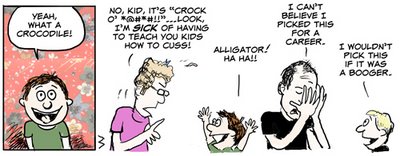
 Since my last entry pertained to editing standards as they're applied to newspaper comics, I thought it would be fitting to go back a few weeks and further illustrate the point with this 4th of July strip that was done for my syndicate.
Since my last entry pertained to editing standards as they're applied to newspaper comics, I thought it would be fitting to go back a few weeks and further illustrate the point with this 4th of July strip that was done for my syndicate.
This particular cartoon would never make it into newspapers. Flatulence gags are a strict no-no. It would be axed the second the sketch hit the editor's monitor. But as I explained earlier, my current syndicate is a bit more lenient.
As it turns out, this cartoon elicited more positive emails from readers than any cartoon I've done in months. As much as I like positive feedback, this is a bit disappointing to me. After all, I try to cover many subjects with varying styles of humor, ranging from subtle social satire to expressive slapstick to politically charged hyberbole.
But a fart joke is what really gets them. It figures.



This "Sunday size" comic is appropriate for today's entry...not only because today is Sunday but also because it underscores the widening difference between newspaper comics and those created for other venues.It used to be that most cartoons adhered to a similar level of 'cleanliness'. There was no cussing, no toilet humor and very little sex. Outside of a few exceptions (like cartoons seen in Playboy magazine and 'shorts' seen in small animation festivals), most everything was edited with the idea that children might see it.Then came Beevis & Butthead, Ren & Stimpe, South Park and a few other animated cartoons that decided to throw all the editing shackles off...mainly because they were aired on cable channels, venues that did not have to follow the same FCC decency standards as network TV.It was a new product and it was a big hit with teenage & twenty-something viewers. Cussing and fart jokes became the rage and many of these same viewers, (a demographic group valued by advertisers), became bored with the now comparatively milquetoast comic strips and cartoons they saw. (Add to this the popularity of the Internet for news and entertainment, and you have very few in that demographic reading a newspaper comic anymore.)If the greatest comic of all time, "Peanuts" were to debut today, it likely would never reach the popularity it attained decades ago. It is simply too clean to appeal to a wide-ranging audience today. Newspaper comics are stagnating, with many features currently published being 50 or 60 years old. (Many of these are reruns from cartoonists who are deceased or comics being produced by hired imitators.)The syndicates are now afraid to lose readers from older generations, who complain loudly to newspapers when comics like Blondie or Beetle Bailey are dropped for something new and probably more relevant. Can you imagine never seeing Seinfeld because the networks refused to make room for it and continued running I Love Lucy or The Honeymooners? Seems ridiculous, but that's exactly what is happening in newspaper comics.Compare the humor and subject matter in comic strips from the 50's to the comics of today. (They're the same.) Now compare the editing standards of 50's era TV shows to shows of today. One has moved forward, the other has not.I don't think that profanity or sex belongs in newspapers and general readership magazine cartoons. But my feeling is that cartoons should be given a little more leeway from newspapers, say along the lines of The Simpsons, (whose content and language would never be allowed under current editing standards), just to be able to compete on a level playing field.Two of my comic strips have been under contract with syndicates, and I have seen the tug and pull between cartoonist and syndicate editor. It is a narrow path to walk as a humor writer, and while it is certainly negotiable, it is not one that leads to a wide readership any longer.Cartoonists are now faced with creating "50's era" comics for a diminished newspaper market, (with less readers and less revenue), or going to the web with a feature that doesn't pay one for the actual cartoons...but allows one to sell T-shirts and posters. (My current comic strip is distributed by a smaller hybrid syndicate, where the main clients are direct email subcriptions, cell phone content providers and popular blogs...and though it looks promising, it has been building slowly.)It will be interesting to see how comic strips evolve over the next few years.



 Since my last entry pertained to editing standards as they're applied to newspaper comics, I thought it would be fitting to go back a few weeks and further illustrate the point with this 4th of July strip that was done for my syndicate.
Since my last entry pertained to editing standards as they're applied to newspaper comics, I thought it would be fitting to go back a few weeks and further illustrate the point with this 4th of July strip that was done for my syndicate.

